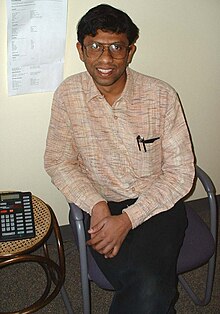Rajesh Gopakumar
Rajesh Gopakumar | |
|---|---|
 Rajesh Gopakumar at Harvard University | |
| Born | 14 December 1967 |
| Citizenship | India |
| Alma mater | IIT Kanpur (BSc, MSc) Princeton University (PhD) |
| Known for | Gopakumar–Vafa invariant |
| Spouse | Rukmini Dey |
| Awards | Shanti Swarup Bhatnagar Award, ICTP Prize |
| Scientific career | |
| Fields | String Theory, Theoretical Physics |
| Institutions | International Centre for Theoretical Sciences Harish-Chandra Research Institute Institute for Advanced Study |
| Doctoral advisor | David Gross |
Rajesh Gopakumar (born 1967) is an Indian theoretical physicist and the director of the International Centre for Theoretical Sciences (ICTS-TIFR) in Bangalore, India. He was previously a professor at Harish-Chandra Research Institute (HRI) in Prayagraj, India.[1] He is known for his work on topological string theory.
Background[edit]
Gopakumar was born in 1967 to Jaishree and G. Gopakumar in Kolkata.[citation needed] His family hails from the southern Indian state of Kerala.[2] He has the distinction of being ranked 1 in the entrance examination for IIT in 1987.[3]
Gopakumar obtained his integrated M.Sc. degree in physics from the IIT Kanpur in 1992. He completed his Ph.D. from Princeton University in 1997 under the supervision of David Gross. After a few years as a research associate at Harvard University, he joined HRI in 2001. He was also a visiting fellow at the Institute for Advanced Study, Princeton, New Jersey from 2001 to 2004.[4]
He is married to Rukmini Dey, a Professor of Mathematical Physics and Geometry at ICTS-TIFR.[5]
Research[edit]
Gopakumar is a string theorist. Early in his career, his research was primarily focused on large N gauge theories with David Gross, noncommutative gauge theories with Andrew Strominger and Shiraz Minwalla, and topological string theory and gauge/geometry correspondence with Cumrun Vafa and is particularly known for proposing the Gopakumar–Vafa duality and Gopakumar–Vafa invariants.[6] Later, his work focussed on attempts to derive the AdS/CFT correspondence, and on minimal model holography (with Matthias Gaberdiel). In recent years, he has made important contributions to higher spin theories and their connections with string theory (with Matthias Gaberdiel). He has also recently worked on the Conformal bootstrap.
Awards[edit]
Gopakumar was awarded the 2004 B.M. Birla Science Prize in Physics.[7]
He received the 2006 ICTP Prize.[8]
He received the Shanti Swarup Bhatnagar Award in 2009.[2]
He was named Fellow of the Global Young Academy of Scientists for 2010.[1][9] He is a member of the Indian National Science Academy, and the Indian Academy of Sciences.[10]
He received TWAS Prize in Physics in 2013.[11]
Selected publications[edit]
- Dijkgraaf, Robbert; Gopakumar, Rajesh; Ooguri, Hiroshi; Vafa, Cumrun (2006). "Baby universes and string theory". International Journal of Modern Physics D. 15 (10): 1581–1586. Bibcode:2006IJMPD..15.1581D. doi:10.1142/s0218271806008978. S2CID 199676528. Archived from the original on 15 December 2012. Retrieved 4 June 2007.
- David, Justin R.; Gopakumar, Rajesh (17 January 2007). "From spacetime to worldsheet: Four point correlators". Journal of High Energy Physics. 0701:063 (1): 063. arXiv:hep-th/0606078. Bibcode:2007JHEP...01..063D. doi:10.1088/1126-6708/2007/01/063. S2CID 8336127. Archived from the original on 15 December 2012. Retrieved 4 June 2007.
- List of R. Gopakumar's Publications
References[edit]
- ^ a b "Academic Report 2010-2011" (PDF). Harish-Chandra Research Institute. Archived (PDF) from the original on 7 April 2019. Retrieved 13 June 2012.
- ^ a b "City scientist chosen for Bhatnagar award". The Times of India. 29 September 2009. Archived from the original on 11 August 2011. Retrieved 13 June 2012.
- ^ Where are They Now? | OPEN Magazine
- ^ [1][dead link]
- ^ "PEOPLE | International Centre for Theoretical Sciences". www.icts.res.in. Retrieved 17 November 2015.
- ^ Gopakumar, Rajesh; Vafa, Cumrun (1999). "On the Gauge Theory/Geometry Correspondence" (PDF). Advances in Theoretical and Mathematical Physics. 3 (1999): 1415–1443. arXiv:hep-th/9811131. Bibcode:1998hep.th...11131G. doi:10.4310/ATMP.1999.v3.n5.a5. S2CID 13824856. Archived (PDF) from the original on 7 April 2019.
- ^ "News Update". IIT Kanpur Alumni Association. 7 March 2006. Archived from the original on 7 February 2012. Retrieved 2012-06-13.
- ^ "The Prize Winners". International Centre for Theoretical Physics. Retrieved 13 June 2012.
- ^ "Members". Global Young Academy. Retrieved 13 June 2012.
- ^ GYA member listing Archived 16 January 2011 at the Wayback Machine, retrieved 2011-03-23.
- ^ "Prizes and Awards". The World Academy of Sciences. 2016.
